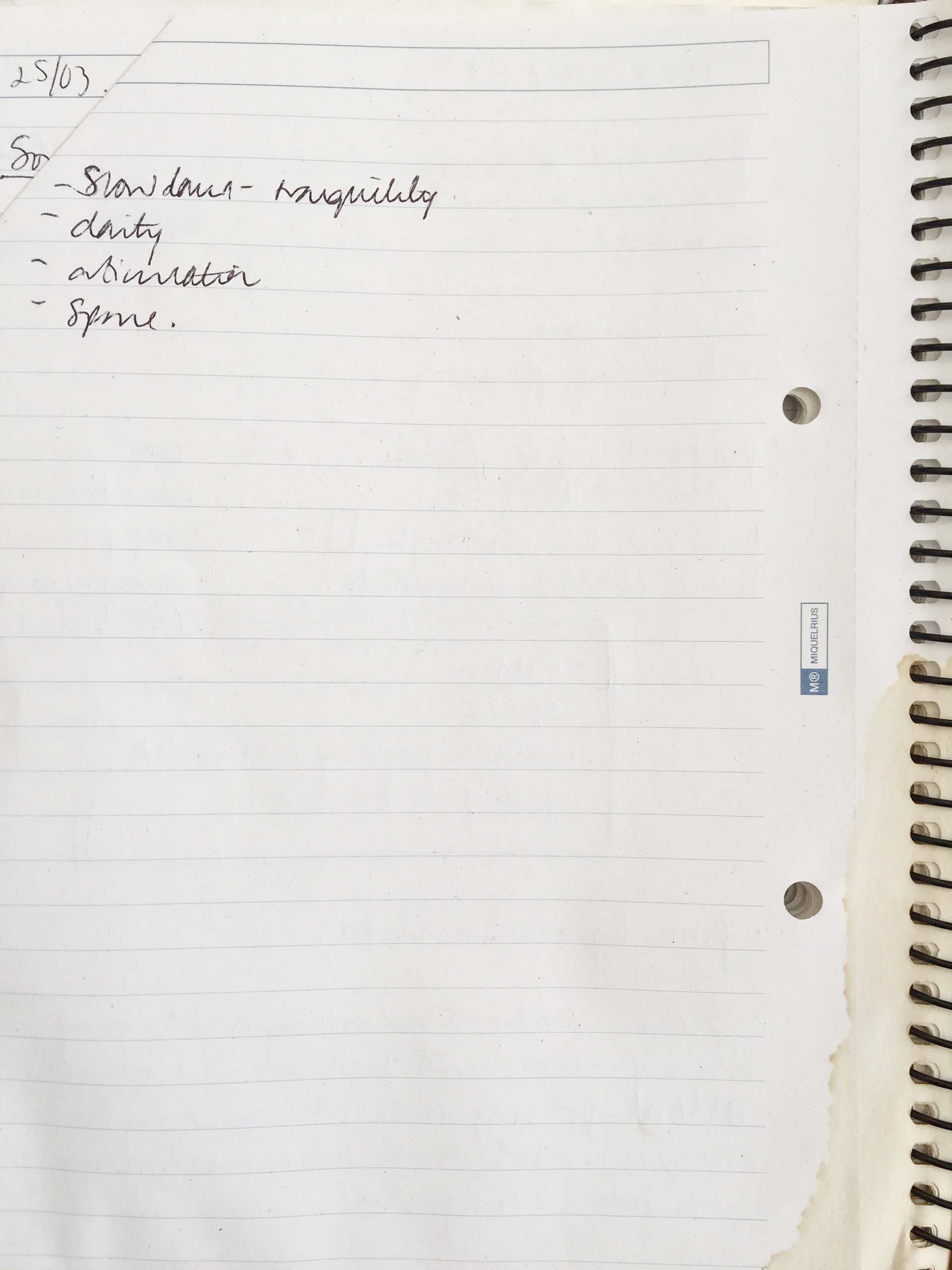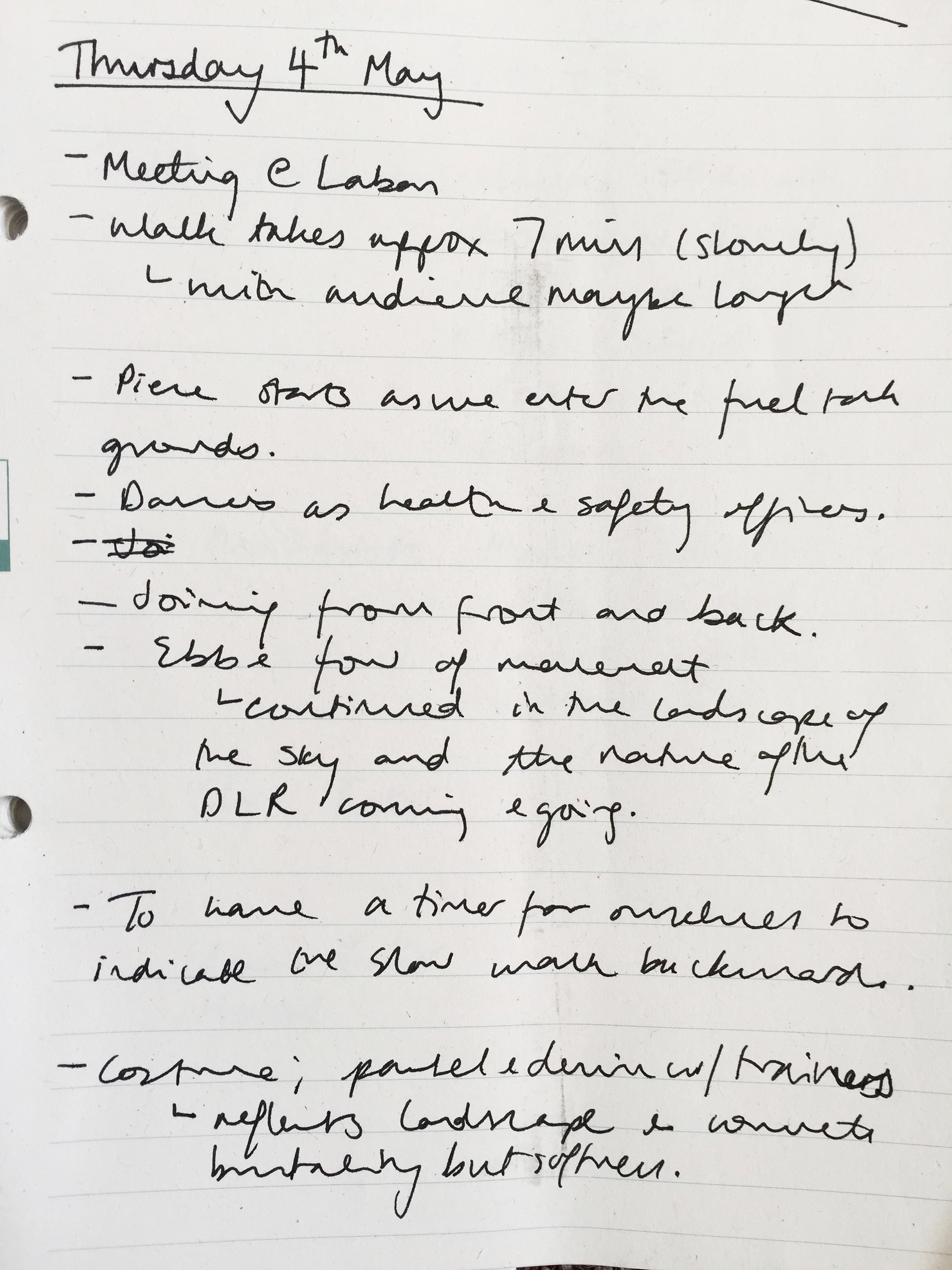Creating A walk to 7 Creekside
Developing my personal research and my work with other dancers, I have drawn the process together and relocated to a new site.
Seeing the piece now as a vessel to continue to explore the research this performance offers a possibility for dancers and audience to experience the process again, and discover anew what was found in the initial walk and how we developed this into movement. Furthermore, the space offers a pre-made stage space created by the strong concrete track and vertical lines of the paving. The DLR which runs intermittently throughout the piece provides a metronome and also opens the viewers perspective.
focussing on details and our spatial relationships in these rehearsals we explored how we could draw connections between one another and the space. Using methods such as counting, referencing the shapes of the architecture and location, using sounds and the texture of the space as well as actually using the space to affect our movement.
Considering the audience and structuring the piece.
Thinking about how I would make the work accessible for an audience, I have been working with my dancers to take the audience to the site. We have then been considering ways in which the dancers can move into the 'performance' space.
This brought to light the fact that actually, I do not necessarily want, or need a clear separation between the dancers and the audience. The whole idea of walking with the audience to the site, takes us back to the starting point.
Furthermore, the dancers will be within the audience, which firstly, separates the traditional performer, audience relationship, but also refers back to my initial research in which I understood the possibilities of the city being a stage. Though, the act of walking is not necessarily a performance, rather an embracement of the banality of the everyday. Or, a rebellion against the conforms of the city.
Therefore-perhaps the audience too are performing.
In regards to this, the dancers will depart the audience when we arrive to the site, however, there will not be verbal instructions for the audience to stop at this point, rather I am slightly interested to see if they feel they should continue into the space where the dancers will be exploring our findings.
The performance will be interesting as an experiment to see how the audience respond to the situation. It will expose how they view their role as audience, and also their awareness of the walking and the space they are in.
The walking to the site also offers the dancers a fresh inspiration on their previous findings and puts them into the mindset of the work and research. It also negates their own boundaries between themselves and the audience and brings them into the everyday-rather than a 'performance mode' as performing on a stage might.
I will have three dancers coming from behind the concrete pillar to help to open the whole space from the beginning of the piece.
Performing the piece at MassHysteriaPresents 29/03/19
At ClimateXchange, hosted by MassHysteriaPresents, I applied to share a version of my choreography. This was a site, accessed through the back of the house from the garden It offered a small alleyway with a space for card to park, a one way street. The back of the space had a street light where the Road then became pedestrianised.
Using the road, I joined the dancers in continuing to play with the improvisation on the recollection of the previous performances. The more we do this improvisation, the more it is possible to move away from the original movement material and start to find something anew. Furthermore, by doing these improvisations in many different sites we are able to be influenced by new spaces and bring back this experience with us.
This performance was a playground for us. It was also a playground for the audience.
Furthermore, not only is the site influencing us, the actual practicality or a different size and shape and also, this time having to move out of the way of cars and also having an awareness of the audience, who I gave chalks to and asked to document what they were witnessing.
The way the cars moved us; making us gather together or separate and have small pause-allowing us to then disperse in the space is an element that I have been trying to find a rule or reason for. This gave me the idea to observe public spaces and note down the geography of the movement there, for example a car park or a road. Furthermore, I could also use the choreography, for example of people at a bus stop to use as a structure for the choreography of my dancers.
With an awareness that the audience had chalks to document our movement, they mainly stayed around the outside of the space. A bigger space with the option of documentation may have made them feel it was more possible for them to document the movement within the space of the dancers. Following the performance I went to look at the space where they had been documenting, to find a wide variety of documentation. Furthermore, watching the footage back of the piece it was interesting to see how the documentation got there and to see in context what the audience were responding to. The audience used many different ways of documenting the movement, for example one audience member marked the location of the dancers feet in space when they had a moment of pause, others documented their own location as viewer, or wrote text, some drew shapes or images that came to mind. Most drew on the tarmac, and one on the wall of the building nearby.
The audiences presence and their ‘task’ meant that there was always some constant movement as they were busy making marks, even when the dancers were still. The stillness of the dancers was actually important in order for the audience to have some time and space to consider what they would like to document or find a detail within it.
A moment of unison or some small moments may be helpful for the audience to have an element of recognition. This unison could be very simple, for example the whole group walking very slowly in a circle or three steps backwards and a jump to the side. They could take movement cues form me and/or use sounds e.g. a loud stamp or clap.
Some moments which were particularly interesting to watch included the slowing at the end. I had a moment of higher energy movement which was a cue to the dancers to slowly begin to move backwards, with the focus still forwards. I was still in a constant state of mainly gestural movement and as I approached the group Nina joined with some similar arm movements, all of us travelling backwards. As I overlook the dancers we continued the slow walk backwards. I think it would have been even more effective if the whole group became closer over a longer period, very slowly coming to a similar distance in space as we get more and more distant from the audience.
This was an interesting test, as, as you can see in the video, the audience were naturally drawn to follow us, even though they were being asked to move in the opposite direction, as we would walk to the end of the alley way and meet them on the other side of the row of houses to begin a performance by Hannah Aebi, based on the idea of flocking. Therefore, to use this slow movement backwards, gradually enticing the audience at the end to the concrete pillar at the back of the space.
Watching the performance back highlights the importance of us constantly considering the use of space, relationships to one another, simplicity, detail and clarity.
For next time; I would give the audience a small piece of paper with ‘instructions’ as well as directions to the site, something I will use for the final performance, or in the form of a booklet with some small details about the piece.
Images of chalk drawings made by the audience of the piece
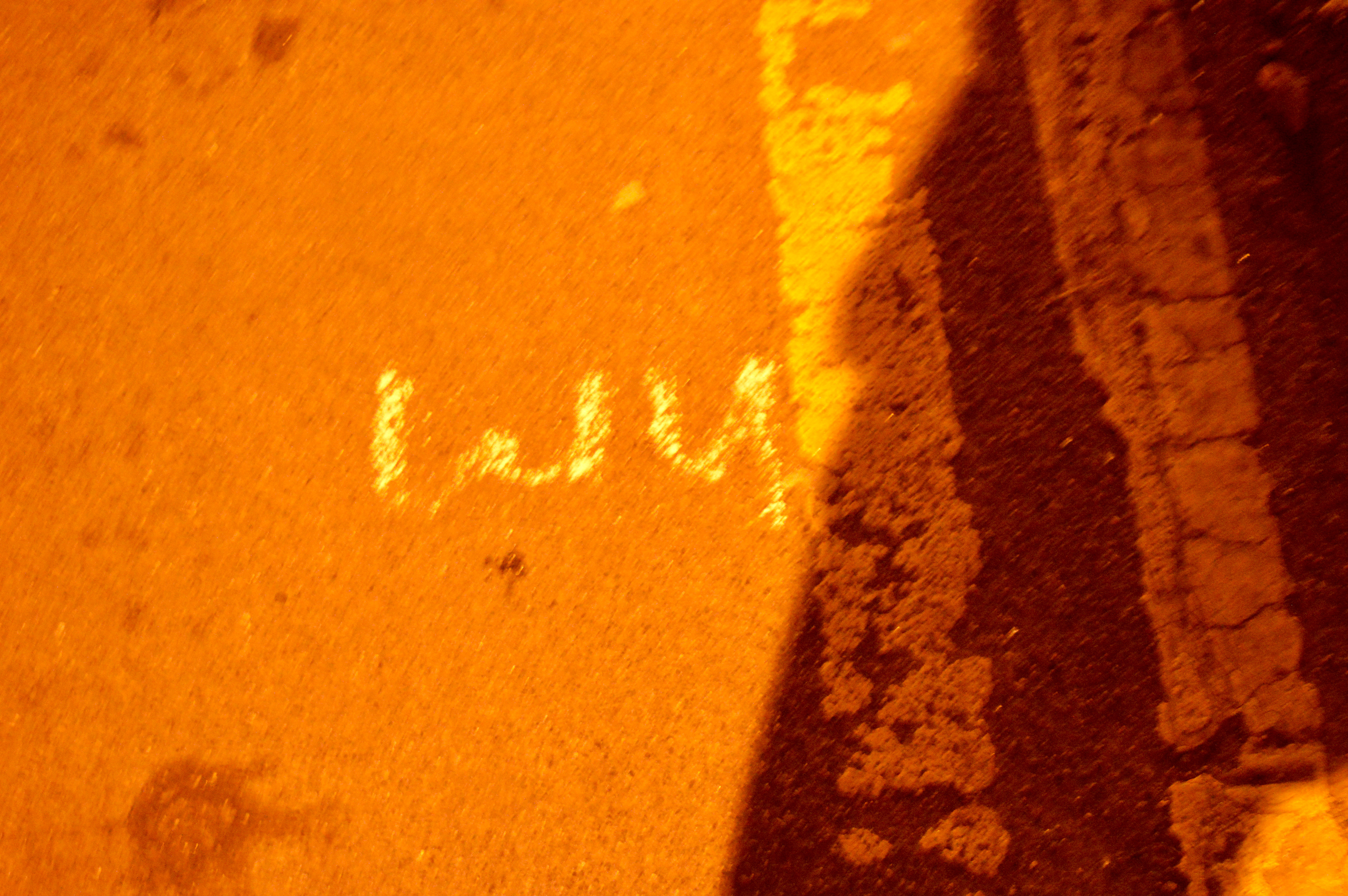
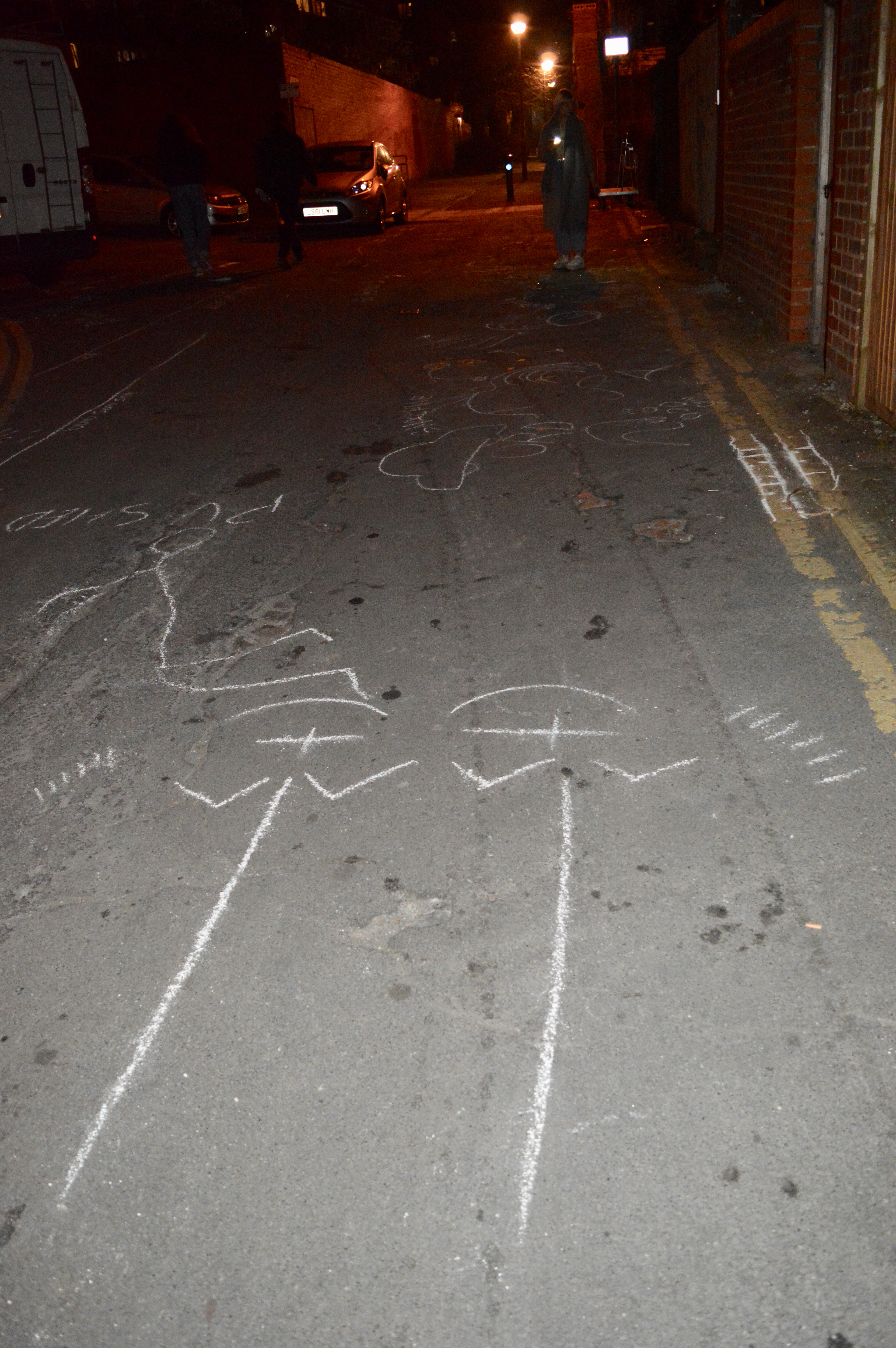




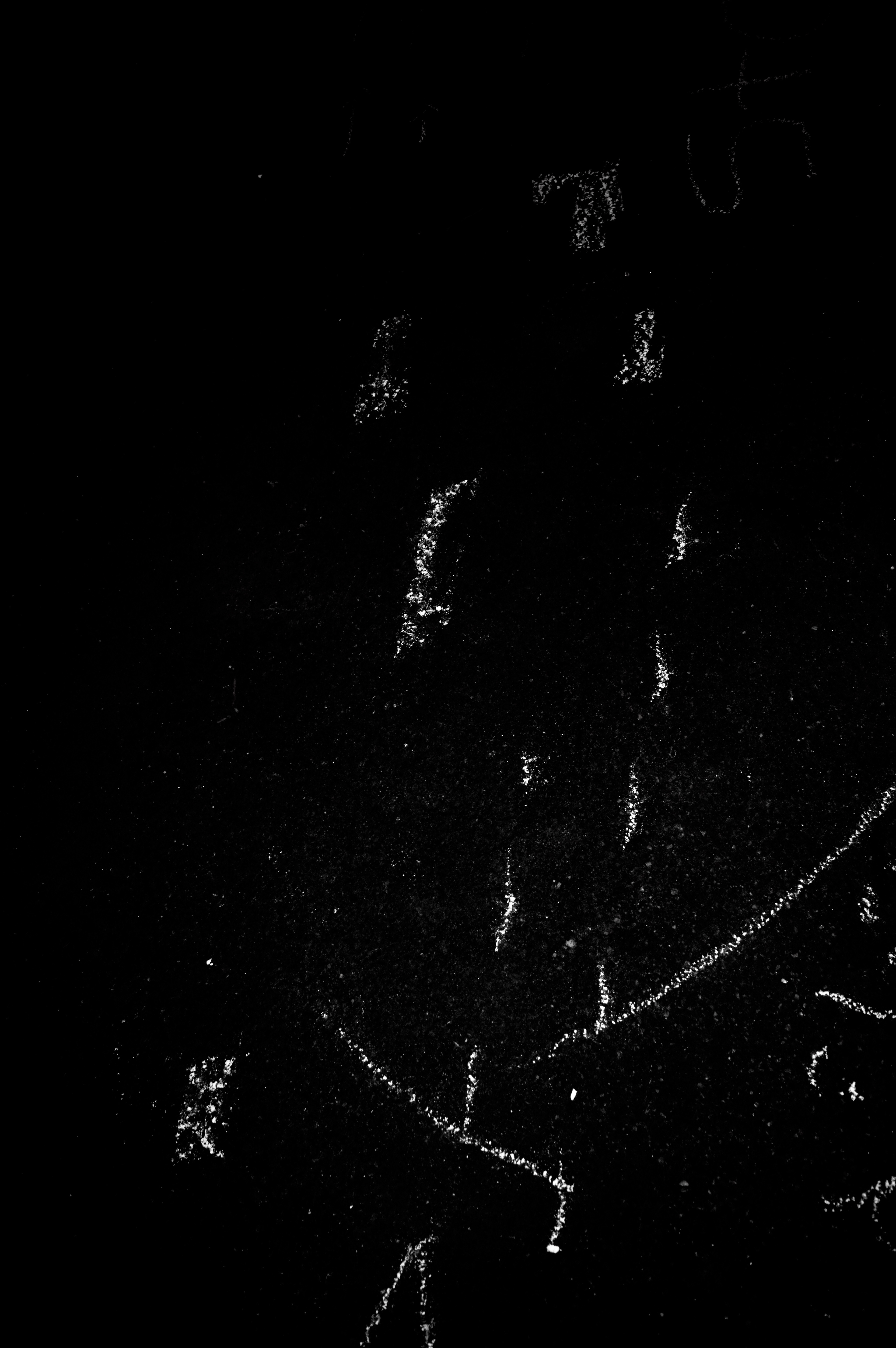

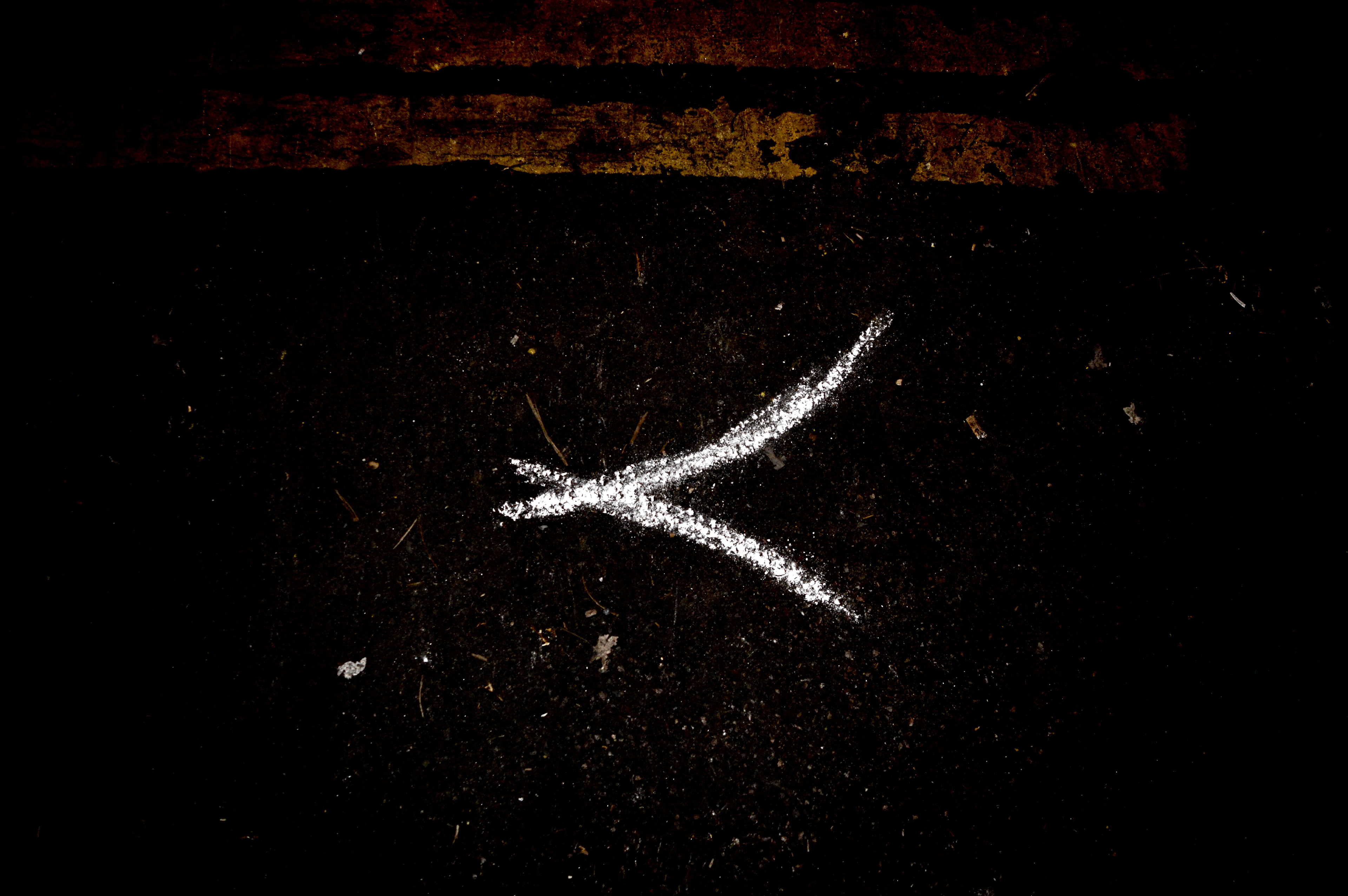
DSC_0011 (video below)
Having an awareness of the effects of the perspective in regard to our relationships to one another can help to draw and leave traces in the space, and also draw attention and focus between dancers.
I would like to have moments where energy builds and then dissipates. It is interesting when this happens travelling towards the camera, for example as I build energy coming forwards, and Lydia picks up on this, travelling with me as if I have swept her up with me (01.19). As we travel towards the front we allow the energy we created to gradually carry us back.
I too many elements change at once, the viewers eye becomes distracted and lost. For example, if we turn and start jumping at the same time. I would like to explore more the idea I had in my movement explorations that the movement develops and builds form one episode to the next, rather than suddenly doing something which can appear very random.
Furthermore, when we are very preoccupied with something it becomes much more convincing and effective. Therefore, to have a task for ourselves would help this.
To consider the ‘lines’ or associations that may be made between the performers can help to give up a better perspective of what the audience would see.
The use of gesture is very effective, for example Nina walking forwards at 05:38. Continuing and repeating similar gestures throughout this walk and then turning around to walk to the back, finally stopping in relation to the others is very effective.
Furthermore, when one behind can see the ones in front, without their awareness it is interesting to see what decisions they make based on the decisions of the other.
Overall, what is, or isn’t interesting to watch is always in relation to what else is happening in the space. However, I like the changes in energies and the contrasts between the faster and slower movement. The very slow exit at the end is fascinating to watch as it is as if the whole world is slowing down - brought into perspective when the DLR train passes.
I left a line of chalks not he platform at the back and asked the dancers to use them throughout the improvisation. We found that not only did we draw on the concrete pillar what we wanted to document ourselves, but we used it to document the movement or pathways of each other as well as looking at the documentation and using it as inspiration again for our own movement.
I discussed with the dancers creating some rules for them.
DSC_0010 (video below)
For example, if someone passes them travelling forwards they must begin a recollection or response to movement number 1. For example, at 5:44 inx the first video when Nina begins falling as I pass her backwards.
Furthermore, a majority of the time, despite the big space, less is actually more. For example, there are moments when I am doing very fast high energy movement, but this is sometimes too much and happening too fast. This more expressive movement is effective, for example with Lydia at 7:12 where she is progressively moving forwards but the rest of the group is in the background, doing something much more minimal. The relationship that Monika and Dominique have here is also very interesting as they both begin with outstretched arms and both gradually, aligning to the same horizontal and then crossing. Hannah breaks this relationship by running through the new group between them once they crossed which then draws a new attention for the audience.
I have put the video in fast forwards, again at the end as I feel this most clearly demonstrates the geographical pathways over time. Watching this it becomes apparent that we could use the passing of the DLR as a cue to gather together and then spread in space. I think that we need to allow things to build, and flow and follow our intention so there is a constant flow of energy, which can ebb and rise and fall but is constantly moving and interacting between us.
Rehearsal 2 28/03/19
Reflecting on this rehearsal
2:30 all still at back with arms raised
5:41 mostly at back, Nina walking down centre
Into 6:30 at back, Lydia stands up
Into everyone very slowly walking out the back and I come to front gestural
come into a unison phrase at some point.
They are structuring the space in collective walks, with hand gestures or small subtle notations with the feet.
Everyone slowly going down to the floor
Hannah and Dominique leaving as a pair
Rebecca the last to leave backwards and Lydia comes forwards.
Slow down, tranquility, clarity, articulation and space.
This rehearsal, helped me to explore further the possibilities with this group and myself in the space and the possible options that we had to play with.
Watching the recording back, I am excited by the perspective that the space offers and how the relationships between people change by using this, furthermore, how the space then opens and closes at moments when there are either many people in one space, or separated and spread in the space. Furthermore, the image of the space is also altered wether these groups or spreadings are towards the foreground or back of the space. This also changed the impact as well as the perception of the movements or shape.
Another very interesting factor is the DLR on the bridge as it frames the same and the choreography - like a signal to the passing of time.
Rehearsal 1 22/03/19
Feedback from the dancers from the process;
they saw it as an exploration of the space, and the people that the space is shared with.
Opportunities fo what they could do and interact with.
It was a chance to discover the space around with potential for everything.
TIME; by taking time in this improvisation there was time for them to become bored in the movement, and therefore find freedom in options.
Changing rhythms was one solution they found to transform the old into something new.
Feeling normal, yet like a silly child.
We discussed the idea of using chalk on concrete, and also allowing the audience to have chalks.
If we go into the audience and invite them in - or could the audience be in the space already?
3D real life. Not a birds eye view means one has to decide who to view-with the audience inside it would mean that they have to decide who to view.
For rehearsal 2 28/03/19
I want to use public constellations of people for example, people getting ready to get on a bus. Looking at the choreography of this and how the dancers could have some constellations in which they could aim to pass through, yet not everyone is complying. This created episodes of people and their relationship to one another taken out of context. Furthermore, this recalls my research of the standards in society and the rebellion of the flaneur.
Rewatching 1&2 with 6 there are some very interesting constellations and relationships and that I need the walking and running in lines which are like waves and a tide.
Furthermore, my choreography can reflect people in public spaces with an aim to get somewhere all with their own agenda but with a common understanding of an attempt at efficiency. We can aim for these constellations but do not always have to abide. We could start by abiding with this and then break away from it- perhaps with direction of walking or also their movement. The individualism of the dancers can also reflect this.
I want the dancers to think they are performing it as if the audience are documenting it.
Just using the rectangle
Chalks will be available to document their pathways or to stop and note a pathway.
USE: movement
Pauses
Changes in speed
Constellations
I will show them some of the film by Robert Wilson as well as some of my own movement research
I want to highlight to them my perspective on the piece, about memory and having a bank of movement that we can access.
To allow themselves to be influenced by the others and let their movement carry you into something else.
Site
Therefore, if I take this movement to a site it frames the work and gives a context to the audience. It can be viewed from the bridge as well as around the space and I would like it to be performed more than once so it can have a chance to renew and the audience may document their experience too.
I have found a site which is behind a building (The Fuel Tank) along creekside. The space was found when I wanted to try 1&2 with 6 - the cottages at a new site. It offers a confined space but it is more open as the left hand side barrier opens onto the creek. Furthermore, it has the track of the DLR on a bridge over the back of the space with a pillar supporting it.
This space supports well my research up until this point, especially, for example, the work of Richard Long and Anna Mendietta-the combination of manmade and organic with the concrete and the creek; in the same way my movement research has explored both of these in urban and natural landscapes.
I would like to try printing images or drawing images to attach to the concrete pillar at the back of the space and also some chalks which could be used to draw in the space.
Considering this it might be interesting for the audience to take a walk to arrive at the site, e.g. from Laban, turn right, right and then across the bridge to the area in context and have their own experience. I could give them books with directions to the site and for them document it. I also thought it may be interesting to have some dancers along the route in order to help guide the audience to the site.
Movement
I would like to experience applying the movement I have developed within the group of everyone else. I feel the piece is about memory and having a bank of movement that I can access. Not a nostalgic memory, rather a memory of the collected movement, which connects to the walk.
I would like to see how the movement would work in a different structure which is not walking in lines. Rather for example using circles. I want to allow more freedom within the structure, rather than seeing it as restrictions. Allowing one to be more influenced by the others; even let their movement carry you into something else. With me part of it, to see what is happening inside.
I would like to buy some chalks and take a platform on wheels to experiment how we ay document in the space using other means.
Adding myself to a work with dancers I worked with previously I would like to be present as the others were, beginning the process of development, acting as a connective tissue, creating connections between dancers. How can what I do connect the viewers eye to someone or how can the viewer be drawn to see a connection between two people.
I think to play with the numbers in space and the speed of us to see how the patterning of us may change which best represents the notion of cartography. My priority is to make visible whatever is happening.
I will develop our relationships and movement proposing to the dancers where they may go next with their movement, what are they responding to? What can they bring to it? For example opening possibilities interacting with the space, lying down, changing dynamics and directions.
In terms of creating a piece, I think that the aesthetic is important, including the costume. Because of the individual personalities the uniqueness of each persons costume is important for me, for example the shape of the clothing or the colour. This will be important in regards to the colours in the landscape of the space. These colours could help to reflect the urban and natural landscape. I am very inspired by the film by Robert Wilson in terms of energy and also aesthetic.
I feel this film as well as the installations offer a huge amount of space, and also a perspective which is constantly changing, opening and closing the viewers vision. Furthermore, whilst the film shows a potentially linear walk it actually offers space for other paths.
Considering linear paths compared to using circles, I have to consider what is the cartography of circles, and is it imprinting something else on the space?
I will also need to consider, if I want to curate the back of the space I will need to consider how to invite the audience to view this area which I propose will be at the back of the space.
Music
The natural sounds become the sound score.
Having documented a lot of walks with hand drawn maps, and then taken these into the studio, documenting the experience through movement. Using the map that I have used to document the experience, generally with line and some landmarks, as well as words or phrases that came to mind, or that I heard.
The movement in the studio is not so much in response to this but using the documentation and interpreting it through movement, as well as it acting as a trigger for my memory of the walk.
The movements have therefore become episodic, snapshots of a great experience as I have collected many small maps of long and shorter journeys with improvisations to go with them. The movement responses to these are a depiction of the walk experienced and documented.
What is interesting about this process of documentation is that it is a constantly renewing process. The movement, which I can trace back to the walk, and then the map, and then the movement, which I can now watch, and remember, and reinterpret. It is therefore constantly renewing in my memory and in actuality, as the actual walk will never be made in exactly the same way again in the same way that the movement will also not. Therefore, whilst the map is an accurate depiction of that walk, the movement perhaps better represents the walk in general, which also changes depending on many variables.
Therefore, the performance that the audience views will be a renewed cartography and they will themselves, through watching make a memory of this - another form of documentation in their mind.
This brought me to the proposition that the audience could also be documenting the performance, in books given to them which would then begin again-or continue this process of documentation, possibly providing more input which could be translated into movements, making a multi layered process. This could feed the choreographic process and help to refine my movement or spatial choices influenced by what the audience witnessed and noted.
Furthermore, the dancers in the space, if it is myself, or also some of the dancers I used previously could make marks within the space, for example with chalks-leaving a reminence of their performance.
Taking my work to a site frames the work in this moment and provides a context for the audience in order for them to be able to make a connection to the work. Furthermore, if I am choosing to depict the movement as a cartography, a space, as in 1&2 with 6 - the cottages, that provides a clear structure, like a vessel in which the choreography or movement can sit.
As I explore this movement more, it becomes clear that a structure of an improvisation in which there is a constant movement, such as the walking forwards and back in my previous choreography, will provide a base for the movement I have researched to sit, be explored and develop, each time renewing itself.
The new site which I am interested in using, which is underneath the DLR tracks, behind the fuel tank, on Creekside, can be viewed from the bridge, crossing the creek as well as in the areas around the space. I could imagine the movement to be performed more than once, for example three 20 minute improvisations allowing me to experience the work anew, possibly with a different audience or at a different time of day. Or the audience could also view it from an alternative location, in order to give themselves a new perspective on the work.
Furthermore, this location would provide the opportunity for the audience to walk to the site, which would allow them to experience what I have been exploring to reach this point. I have also considered if the audience should be given something with which they could document their experience, such as the notebooks that I used myself and with my dancers. This could also be done with photos, videos and other methods of documentation with the same freedom I gave my dancers.
Taking my movement responses I am now trying to contextualise these together, within a framework. I want to develop a structure that I might be able to place the movements within providing freedom for me to explore where they may take me but a clear structure is required in order for the freedom to be found.
Some things that I have explored in rehearsals include;
Making a list of key points or movements that I must pass through
Relating these points or moments clearly to the walk that they were documented from as well as an image of the map. Referring back to not only the movement but also the original map will ensure that not only the original is being referred to but also the map and the movement can provide very different sources of reference - the two together providing more information than one alone.
I have also considered having cues which could initiate movements, like the cues that the dancers had, which were one another. These could be sound cues, cues from the audience that I can predict or wait to be influenced by, things I see, or things that happen in the performance space. For example I could have a list of ‘moments’ which could be cued in succession, or each moment has a different cue which could be known or unknown. If unknown the movement is then chosen from a bank of movements spontaneously in response to an external cue.
I could also have maps in the space, or images of my maps from which I could recollect the walk and my response, bringing both into movement.
I could also assign a collection of images, a colour, name or shape which could then be present in the space.
Within any of the movement, the importance for me is precision and clarity in my movement within myself in order for it to effectively communicate anything and be perceived by the audience.
I would like to have a simple, continuous flow of energy and movement within which the details can become apparent, constantly transforming and growing waxing and waning like the moon.
Some things I considered following my first rehearsal bringing everything together is how can I continue the cued movement within a constant flow of movement and energy.
How is the quality as well as the form of the movement considered? For example, the tension or speed of a cue.
I am starting to find more interest in how sounds that I create can become the sound score, or how this could be built upon. This could also be considered in the way I structure the movement, if or when I pause or slow down or speed up.
Overall, I must be wholly committed to the movement or idea and only use the movement that is necessary-no movement for the sake of it, highlighting the efficiency of what I am doing and the importance of this, especially when I am thinking in the context of a map, it is providing to the user only the information which is essential for them to locate themselves in space and get somewhere. In the same way, within my movement I need to be specific about where I am locating myself in space not only for my own but the audience’s awareness.
This has made me aware of the importance of the specificity and clarity of what I am doing. In order to be clear and specific I need to know myself, in my body what something is, defining each movement with a physical or also a detail of focus, energy or direction. Therefore, I can provide to the audience, and myself a clarity of intention shape, form and energy which will help to curate the space I am structuring it with my body and movement, potential in, and around the audience. Presenting the movement as if the audience are documenting it, regardless of if they are or not, will help to provide clarity to them and myself.
I regards to the use of the site, this will depend on attaining certain permissions for the audience to come to the site. If this is not possible, I would record the movement and share it as a film within a curated exhibition space.
I think I would like to work with some of the dancers I was working with previously in a series of workshops where I can experiment with some ideas.




